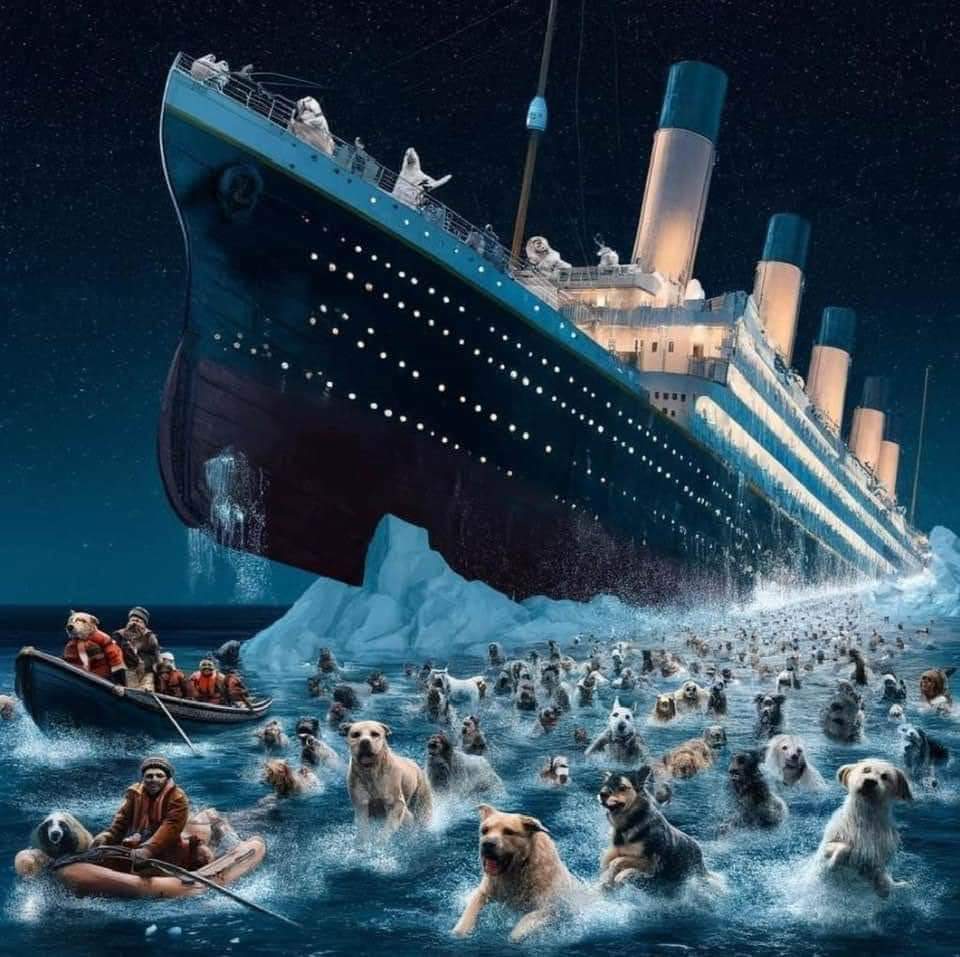
A TITANIC ANALOGY FOR ANIMAL WELFARE
Imagine a huge ocean, overflowing with life, but also full of danger. In this metaphorical sea, the animals we love and cherish are like passengers aboard a grand vessel—the Titanic of our time. Like the tragic fate of the Titanic, where rescue wasn’t an option for many, today’s animals face an equally dangerous predicament: the struggle for survival in a world where their welfare is often disregarded and there are not nearly enough homes for all, never mind good homes.

THE RESCUE BOATS
Rescue organizations and shelters serve as the humble rescue boats in this vast ocean of animal welfare. They tirelessly navigate the turbulent waves, striving to save as many lives as possible with their limited resources and capacity. Yet, despite their unwavering dedication, they find themselves overwhelmed by the sheer magnitude of the crisis.
Every day, rescue organizations are confronted with heart-wrenching decisions akin to deciding who boards a life raft and who is left to face the icy depths alone as the ship sinks. When an owner surrenders their pet for reasons ranging from inconvenience to inability to care, it’s akin to asking for space on that fragile raft. But each addition to the raft means another sentient being must be denied rescue, left to perish in the unforgiving waters of neglect and abandonment.

THE TITANIC OF OUR COMMUNITY
In contrast to the modest rescue boats, the community at large represents the Titanic — a representation of societal norms, attitudes, and practices regarding animal welfare. From breeders and pet shops to irresponsible owners and those who neglect to spay and neuter, the iceberg looms, threatening to sink the hopes of countless animals.
The chilling truth, an iceberg not visible to many, is that the current approach—relying solely on adoption, education, and sterilization—is insufficient to stem the tide of suffering. The iceberg of systemic issues continues to grow, casting a shadow over the prospects of meaningful change. Despite our best efforts, appeals for compassion often fall on deaf ears, leaving legislation as the lone beacon of hope on the horizon, unless society opens its eyes to see what is right in front of them.

THE SOS OF SOLIDARITY
Amid chaos and despair, there echoes a solemn cry for help—a distress signal that vibrates across the vast expanse of the ocean. This call to action is the SOS of solidarity, a rallying cry that unites individuals, organizations, and communities in a shared mission to alleviate the suffering of animals.
Much like the SOS signals sent out by the Titanic as it plunged into the depths, our collective plea for solidarity serves as a beacon of hope amidst the darkness. It signifies our willingness to stand together, extend a helping hand to those in need, and to navigate the treacherous waters of animal welfare with determination and resolve.
By embracing the spirit of solidarity, we acknowledge that the challenges we face are not unconquerable. Together, we can weather the storms, overcome the obstacles, and chart a course towards a brighter future for all creatures, great and small. For it is only through unity and compassion that we can hope to save them all.

THE COMPASS OF COMPASSION
Amidst the dangerous seas of animal welfare, there exists a guiding light—a moral compass that points toward empathy, kindness, and compassion. This compass of compassion serves as our navigational tool, helping us steer through the moral and ethical dilemmas that define our journey.
Just as the crew of the Titanic relied on navigational instruments to chart their course, so too must we as a society rely on the principles of compassion to guide our actions. It is this unwavering commitment to empathy that compels us to extend a helping hand to those in need, regardless of species or circumstance.
However, like any compass, our moral direction is subject to deviation. In the turbulent waters of modern society, it’s easy to lose sight of our moral bearings, to become adrift amidst the currents of apathy and indifference. Yet, it is precisely in these moments of uncertainty that our commitment to compassion must shine brightest.
By reorienting ourselves as a society, towards the true north of empathy, we can navigate the complexities of animal welfare with clarity and purpose. It is through the collective alignment of our moral compasses that we can hope to steer toward a future where the cries of the innocent are met with compassion and action, rather than silence and neglect.
THE RIPPLES OF RESPONSIBILITY
Just as the sinking of the Titanic sent shockwaves across the world, so too does the plight of animals echo far beyond the confines of their immediate surroundings. The ripples of responsibility extend outward, touching the shores of our collective consciousness and challenging us to confront our role in their fate.
Every action, or inaction, has consequences that echo through the vast expanse of time and space. Whether it’s the decision to adopt a pet from a shelter or to spay and neuter your pets, each choice sends out a ripple that can either contribute to the solution or exacerbate the problem.
Just as the crew and passengers of the Titanic struggled with their individual responsibilities in the face of disaster, so too must we acknowledge our role in shaping the destiny of animals. It is not enough to simply be crying for the tragedy unfolding before us; we must each take ownership of our actions and strive to make a positive difference, however small it may seem.
By embracing our collective responsibility towards animals, we can harness the power of individual actions to effect meaningful change on a global scale. Just as a single pebble creates ripples that spread outward, so too can our efforts to advocate for animal welfare create waves of compassion that wash over society, transforming hearts and minds in the process.

THE LIFE BUOY OF LEGISLATION
Legislation, when enacted and enforced properly, serves as a life buoy for each animal. These legal frameworks can offer extra tools to the rescue organizations and a lifeline to those who would otherwise be left to fend for themselves in a sea of neglect and cruelty. However, much like the limited capacity of the Titanic’s lifeboats, legislation alone cannot bear the full weight of the crisis. It requires the collective effort of society (the ship) and the animal welfare organization (the rescue boats) to ensure that these life buoys are not only available but also accessible to those in need. Legislation can hold the potential to rescue countless creatures from an otherwise tragic fate because the rescue boats will have more tools at their disposal.
A CALL TO ACTION
Just as the Titanic’s fate was sealed by a series of unfortunate events, so too is the fate of countless animals in our world today. But unlike the Titanic, where rescue came too late for many, we have the power to alter the course of this narrative. By advocating for stronger legislation, promoting responsible pet ownership, and supporting organizations dedicated to animal welfare, we can rewrite the ending to this tragic tale.
THE LEGACY OF LESSONS LEARNED
As the Titanic tragedy left an unerasible mark on history, so too will our handling of animal welfare shape the legacy we leave for future generations. Just as the lessons learned from the Titanic disaster led to advancements in maritime safety, so too can we draw wisdom from our experiences to forge a brighter future for animals.
The mistakes of the past serve as cautionary tales, reminding us of the consequences of arrogance, neglect, and indifference. Yet, they also offer opportunities for growth and redemption. By acknowledging our shortcomings and learning from our missteps, we can pave the way for a more compassionate and enlightened society.
Just as the survivors of the Titanic emerged from the wreckage with a newfound appreciation for the fragility of life, so too can we emerge from the trials of animal welfare with a renewed commitment to do better. It is through our collective efforts to heed the lessons of the past that we can chart a course toward a more just and equitable future for all beings.
In the end, the true measure of our legacy will not be found in the grandeur of our achievements, but in the depth of our compassion and the sincerity of our commitment to those who cannot speak for themselves. Let us strive to leave behind a legacy of compassion, one that honors the inherent dignity and worth of every living creature, and ensures that the lessons learned from the trials of today serve as a beacon of hope for generations to come.
In the vast ocean of animal welfare, the Titanic analogy serves as an important reminder of the challenges we face in our quest to save them all. But amidst the stormy seas and looming icebergs, there remains hope—a flickering light of compassion that refuses to be extinguished. Let us heed this call to action, lest we allow the cries of the innocent to be drowned out by the silence of indifference. For in the struggle to save them all, our humanity is truly put to the test.
Take better care of your animals, educate others, and support those who are in the water every day, tirelessly trying to save as many as they can.
Next week we will revisit how to avoid high vet bills.
WHEN YOU KNOW BETTER, DO BETTER!